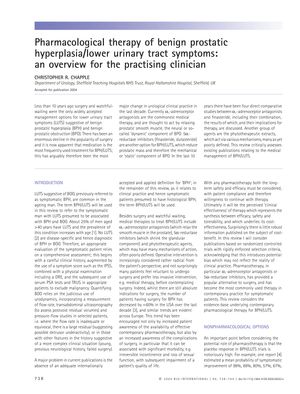Pharmacological Therapy of Benign Prostatic Hyperplasia/Lower Urinary Tract Symptoms: An Overview for the Practicing Clinician
August 2004
in “
BJU international
”

TLDR Medications have become the main treatment for enlarged prostate symptoms, replacing surgery and watchful waiting.
As of 2004, the management of lower urinary tract symptoms (LUTS) suggestive of benign prostatic hyperplasia (BPH) and benign prostatic obstruction (BPO) had shifted significantly from surgery and watchful waiting to medication, marking a major change in urological clinical practice over the previous decade. The most common medical therapy at the time were α1-adrenoceptor antagonists, which are believed to work by relaxing prostatic smooth muscle, addressing the 'dynamic' component of BPO. Another treatment option included 5α-reductase inhibitors (finasteride, dutasteride), which reduce prostatic mass and target the 'static' component of BPO. The document discusses four direct comparative studies between α1-adrenoceptor antagonists and finasteride, including their combination, and examines their results and implications for therapy. Additionally, phytotherapeutic extracts were mentioned as another group of agents with various, often poorly defined mechanisms of action. The review critically assesses the medical management of BPH/LUTS based on existing publications up to that time.



